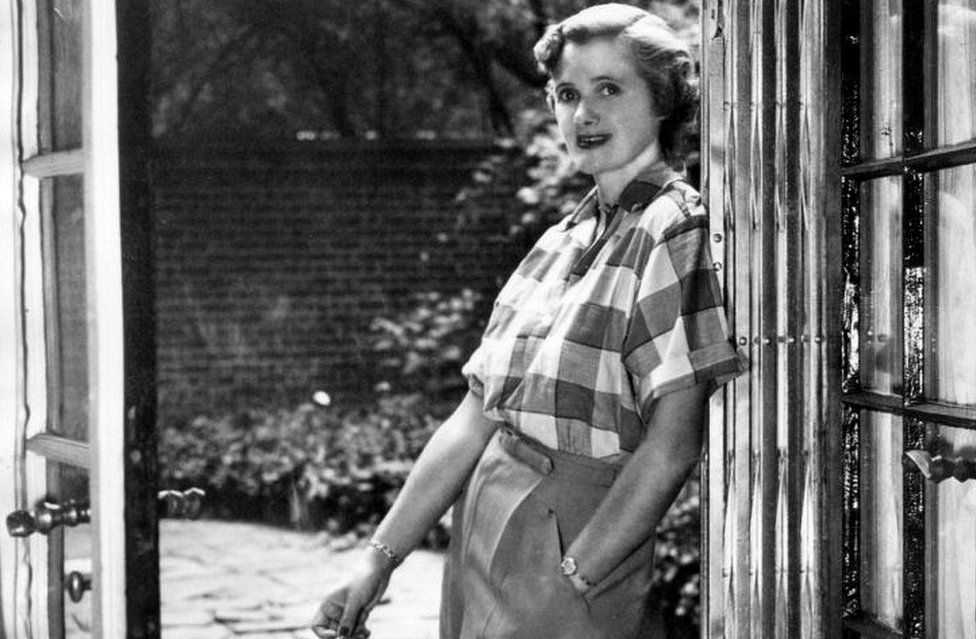ARTICLE AD BOX
By Hugh Schofield
BBC News, París
 Image source, UNITED PRESS PHOTO/AFP
Image source, UNITED PRESS PHOTO/AFP
Dame Daphne du Maurier, the English novelist who died in 1989, was fascinated by her French heritage.
The author of Rebecca and Jamaica Inn had been brought up on tales of an aristocratic ancestor who came to London during the French Revolution, fleeing the guillotine and the militant sans-culottes.
But when she began looking into her family history, she discovered it was all rather more complicated. Far from being nobles, her French ancestors were in fact bourgeois artisans whose trade was glassmaking.
And the 1790 émigré was not a runaway from the revolutionary mob, but from a debtors' prison.
Today it is possible to retrace the footsteps of Daphne du Maurier, as she carried out her research in France in the 1950s. Driving around the Perche region, 120 miles (190km) south-west of Paris, she visited the farmsteads, châteaux and glass foundries that featured in her family story.
Image source, Anne Hall: Sur les pas de Daphné Du Maurier
Image caption,Du Maurier featured an old glass foundry in her 1963 novel The Glass-Blowers
They became the setting for her 1963 historical novel The Glass-Blowers, in which she told of her great-great-grandfather Robert Busson, of his modest roots making perfume bottles in the forests near Le Mans, and how he came to sire an artistic dynasty of English du Mauriers in London.
The starting point of her travels was the house in the village of Le Gué de Launay which was once the home of her ancestor's sister, a woman called Sophie Duval.
It was Sophie's letters, written in the 1840s and now preserved at Exeter University, that formed the basis of all future investigations, because in them, Sophie looked back at her own long life. She was born in the 1760s, the daughter, sister and then the wife of glass-blowers.
Daphne du Maurier set the opening scene of her novel The Glass-Blowers on the terrace of the house, and it is still there much as it was, hidden amid the wooded vales and pastures.
"Daphne du Maurier came here to get a sense of place for the opening of her book," says the current Anglo-French owner Mary Buisson, herself a fan of the author.
"We used to read her books under the sheets at our convent. Who would have thought I would end up in the house of her ancestor?"
This part of France is still very forested. Back in the 18th Century, it was even more so. This, plus probably the arrival of Italian craftsmen at some unrecorded point in medieval time, led to it becoming one of the country's main centres of pre-industrial era glass manufacture.
"To make glass, you need three things: wood, clay and sand. Here, they had them all in abundance," says Bernard Malcor, an expert in the old verreries or glass foundries. His family has lived in the nearby village of Le Plessis-Dorin since 1803.
In Le Plessis-Dorin was one of the foundries that Daphne's ancestors managed in the years before the French Revolution. Indeed, it was while based here that du Maurier's ancestor, Robert Busson, began the commercial business that eventually went bust, requiring him to leave post-haste for the channel ports.
A successor to the original foundry kept going until the 1950s, employing hundreds of local workers and supplying phials for scent-makers like Guerlain and Coty. But then, as with all the verreries, hard economics took over. Unable to compete with the big new factories, they closed.
Not much is left now of the old glass foundry at Château de La Pierre
But the woods and fields have their memories. Today, there are scores of place names including the word verrerie, and locals still turn up lumps of what looks like vitreous rock: molten dregs from the furnaces, which were smashed and used as aggregate to line the muddy lanes.
"Over the centuries, there would have been hundreds of glass foundries in the forests. They would consume the wood in a given area, then just move on. It was a bit like slash and burn in the Amazon," says Frédéric de Montalembert, whose Château de La Pierre has another du Maurier connection.
The émigré's father, Mathurin Busson, managed the verrerie at La Pierre when Robert was a boy. During this time, the family, who were only of the upper artisan class, had permission to live inside the château.
Did this give Robert Busson delusions of grandeur? All we know is that having left for London, he took the name du Maurier and let it be erroneously understood that he was titled.
From Robert Busson du Maurier, there then sprang the line that came down to Daphne.
In between were other du Mauriers of artistic renown. Robert's son was an inventor, and his son - Daphne's grandfather - was the novelist and Punch cartoonist George du Maurier.
In his day, George was every bit as famous as Daphne. The social commentary of his cartoons helped create modern British humour, while his novel Trilby - apart from indirectly giving the name to the hat - was also one of the first blockbusters.
Image source, Getty Images
Image caption,This du Maurier cartoon pokes fun at the fact that it is the lady who feasts on flesh not the hippo
His son, the actor-manager Gerald du Maurier, was Daphne's father.
Did all these generations of du Mauriers believe in their supposed aristocratic past? Or did they suspect it was a fake?
There is no clear answer. Certainly, Daphne seems to have been sold the "noblesse" line by her father Gerald, so that when she debunked it in the 1950s, her discovery of the family's more ordinary roots felt like a surprise.
"She was not at all snobbish," says American academic Anne Hall, who lives in the Perche region and has made a study of the du Mauriers' French connection. "So she was genuinely very proud when she found out her ancestors were craftsmen."
But Anne Hall says there was probably a bit of family myth-making as well. She has discovered that George du Maurier, who was born in Paris in 1834, spent holidays as a boy with his letter-writing great-aunt Sophie Duval at Le Gué de Launay.
As she was a living link with the glass-blowing past, he surely would have got more than a hint of it.
For Daphne du Maurier, as for the curious visitor today, the end of the journey is an hour's drive to the south from the verreries of Le Plessis-Dorin and La Pierre, at another abandoned glass foundry, called Chérigny.
In the 1760s, the patriarch Mathurin Busson was working and starting his family here.
Image source, James O'Mara
They lived in a small farmhouse, whose name was Le Maurier, and in 1747, that is where Robert Busson, the émigré, was born. He took his "title" not from a château, but from the cottage where he first saw light of day.
The farmhouse is still there, one of a million French farmhouses you see signposted off the main road and then drive down a mile of rutted track to reach.
The Léon family received a visit almost 50 years ago from Daphne du Maurier as she retraced her ancestors' steps
The same family - the Léons - has been farming there for the last 80 years. And yes, they do get the occasional visit from a du Maurier tourist.
Daphne herself came, they recall, and in the house is a keepsake that proves it.
It is a French paperback version of The Glass-Blowers, with a personal dedication.
Where my ancestors lived, Respect and Best Wishes, 23rd September 1973. Daphne du Maurier.

 2 years ago
62
2 years ago
62








 English (US) ·
English (US) ·